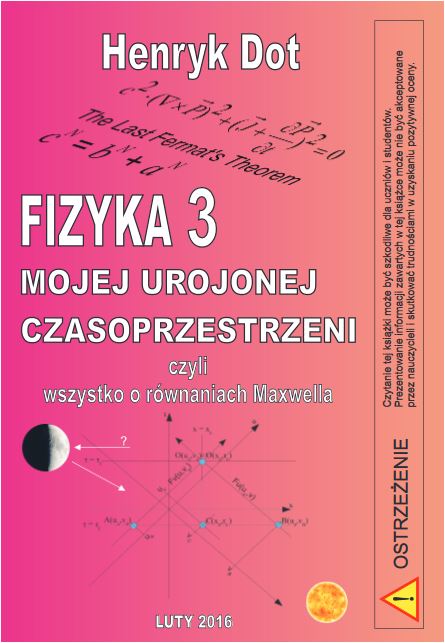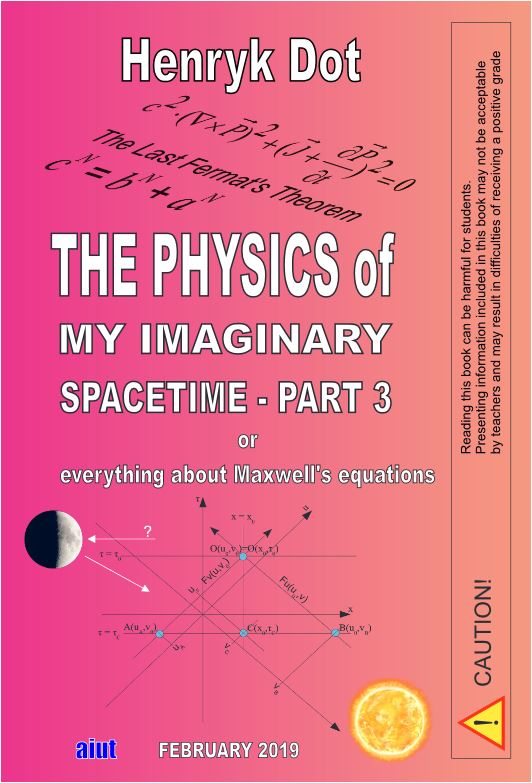★ HenrykDot.com
★
is the online companion to a series of books published by AIUT under the common main title
"Physics of My Imaginary Space-Time" by Henryk Dot.
is the online companion to a series of books published by AIUT under the common main title
"Physics of My Imaginary Space-Time" by Henryk Dot.
Home
Physics 3 - Maxwell
Note from the Author
Table of Contents
What is this book
Historical facts
New aspects
Fully erroneous
Incorrectly interpreted
Physics 3 - Chapter 1
Equations
Complex vectors form
The Most General form
The General Solution
Physics 3 - Chapter 2
Solutions
Initial conditions
Non-homogeneous equation
Solution for three-directions
The four laws
Physics 3 - Supplement
Fermat's proof
Beal's conjecture
Pythagorean triples
Inertial mass
Gravity constans big G
What does the Moon look at?
Physics 3 - Final notes
Final notes
Physics 4 - New book
Entry
Physics 3 - Maxwell
Note from the Author
Table of Contents
What is this book
Historical facts
New aspects
Fully erroneous
Incorrectly interpreted
Physics 3 - Chapter 1
Equations
Complex vectors form
The Most General form
The General Solution
Physics 3 - Chapter 2
Solutions
Initial conditions
Non-homogeneous equation
Solution for three-directions
The four laws
Physics 3 - Supplement
Fermat's proof
Beal's conjecture
Pythagorean triples
Inertial mass
Gravity constans big G
What does the Moon look at?
Physics 3 - Final notes
Final notes
Physics 4 - New book
Entry
Contact
email: henryk.dot(at)aiut.com
"Subject" should begin with
a digit corresponding to the day
of the week., e.g. Sunday=7
"Subject" should begin with
a digit corresponding to the day
of the week., e.g. Sunday=7
Books published by AIUT
are found in libraries according to the list of compulsory copies.
Second Edition of "Fizyka 3"
ISBN 978-83-926856-1-6

can be bought in Warsaw
in the Academic Bookstore
PW Publishing House
Noakowskiego street 18/20
and in Katowice
in the bookstore "Liber"
Bankowa street 11.
(area of Silesian University)
English edition of "Physics"
ISBN 978-83-926856-2-3

is also in libraries
and the distribution method should be asked wydawca@aiut.com.
|
to fields and we can apply and coefficients from formulas (1.23) and (1.24) to all equations (1.6 – 1.9). We assume the coefficients and which results for sum of (1.6) and (1.7) in: . For (1.8) i (1.9), we divide first (1.9) by | |
| . | (1.27) |
|
The sum of (1.8) with coefficient
and (1.27) with coefficient is equal to: , therefore | |
| . | (1.28) |
|
We can see that by using the same coefficients
and ,
which were used in (1.24) for , following complex variables can be created for general sources: | |
| , | (1.29) |
| (1.30) | |
| and consequently, we can express Maxwell’s equations in shorter form: | |
| , | (1.31) |
| . | (1.32) |
|
We have assigned the subscript t to variable
thus designating variable
without a subscript for even more general expression by introducing time variable , therefore (1.32) can be written as: | |
| , where | (1.33) |
|
This equation together with (1.31) present the shortest form of Maxwell’s equations and reduces sizes of resulting equations
in subsequent operations. . 1.5. Even More General Notation of Equations Therefore, equation below | |
| (1.34) | |
|
represents Maxwell’s equations as well, so both versions, (1.33) and (1.34) should be always presented. However, both versions can be written in one equation when we square both sides of equations which yields: , therefore | |
| (1.35) | |
|
This is interesting expression, and perhaps can inspire some philosophical reflections on the essence of Maxwell’s equations. It can be noted that represents static, while dynamic phenomena. Expression (1.35) includes both possible versions (1.33) and (1.34) thus represents the highest degree of generalization. It should be remembered that variable for (1.33) is expressed by , while for (1.34) is expressed by . In search for solutions of Maxwell’s equations it is sufficient to consider only one of the versions. Therefore, in later chapters we will deal only with version (1.33). | |
© 2020 Henryk Dot -
